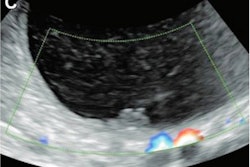
Although radiologists still perform the most image-guided paracentesis and thoracentesis procedures, advanced practice providers are taking on a greater role, according to new research published in the Journal of the American College of Radiology.
A team of researchers led by Joshua Tublin of the University of Pittsburgh School of Medicine reviewed Medicare claims data from 2012 to 2018 for paracentesis and 2013 to 2018 for thoracentesis procedures. The group found that the number of ultrasound-guided paracentesis and thoracentesis procedures increased, with radiologists still performing the overwhelming majority of procedures. Advanced practice providers were cutting into their share, however.
"Given decreasing reimbursement for these procedures, [advanced practice providers] can provide a large cost advantage in procedural radiology practices," the authors wrote.
Paracentesis is performed for drainage of ascites, while thoracentesis is conducted for drainage of pleural effusions. A variety of specialties perform these minimally invasive procedures, which can be performed with or without ultrasound guidance.
The researchers had hypothesized that the number of ultrasound-guided procedures performed by radiologists increased dramatically given the strong evidence demonstrating the effectiveness of the technique. They also hypothesized that advanced practice providers were performing more of these procedures.
These hypotheses were confirmed after reviewing the Medicare claims data after current procedural terminology (CPT) codes were adopted in 2012 and 2013 for these
procedures. Radiologists performed 222,673 ultrasound-guided paracentesis procedures in 2018, up from 187,168 in 2012. In addition, radiologists performed 147,310 ultrasound-guided thoracentesis procedures in 2018, compared with 137,758 in 2013.
However, the percentage share performed by radiologists dipped for both procedures due to a significant increase in volume and percentage share of procedures performed by advanced practice providers.
| Growing share of advanced practice practitioners in performing image-guided paracentesis and thoracentesis | ||||
| Radiologists | Advanced practice practitioners | |||
| Year | 2012 | 2018 | 2012 | 2018 |
| Percentage of image-guided paracentesis procedures performed | 83.9% | 77.1% | 10.2% | 15.8% |
| Year | 2013 | 2018 | 2013 | 2018 |
| Percentage of image-guided thoracentesis procedures performed | 73.6% | 66.2% | 7.7% | 12.9% |
"Because of their training with image-guided procedural techniques, expertise with image interpretation, and availability and familiarity with ultrasound and CT equipment, radiologists are well positioned to perform these procedures safely and develop comprehensive image-guided procedural practices," the authors wrote.
However, the most striking trend to emerge from the study was the dramatic increase in procedure volume from advanced practice providers, according to the authors. This growth was in line with a national trend over the last decade toward greater participation of advanced practice providers in clinical care.
Many radiology departments have recognized the financial value of having advanced practice providers perform minimally invasive procedures, according to the authors.
"Although [advanced practice providers] can bill Medicare for procedures at a rate of 85% of what physicians can, their salaries are typically at most one-third the salary of a radiology physician," the authors wrote. "Therefore, having an increasing share of procedures safely performed by [advanced practice providers] can decrease costs and increase revenue for health care systems by freeing radiologists to perform a greater volume of image interpretation or more complex procedures," the authors wrote.




















